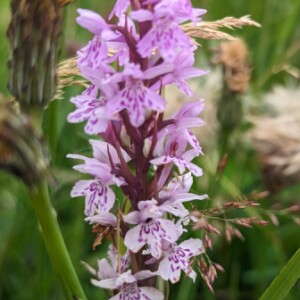What's in a name
At least as far back as Plato, bees have been a symbol of industry and co-operation, so it's probably no great surprise that the Youlgrave Industrial & Co-operative Society selected them as a symbol of its enterprise. 1872 was only 20 years after Lorenzo Langstroth patented the moveable frame hive so, at the time, I expect most bees in this area were indeed kept in skeps of woven straw - but images like this are almost timeless, and certainly go back as far as early medieval wood carvings. Wheat is a symbol of wellbeing and prosperity. The other plant looks like a foxglove to me - it must have meant something to the founders
The co-op sadly is no longer trading, but the building has been repurposed as a youth hostel and includes a lovely cafe that provided frittata and cinnamon buns for our packed lunch. Youlgreave was the starting point for our day's walk. Note the inconsistent spelling. The locals, the parish council and the village name signs drop the 'e'; the county, the Ordnance Survey and the road signs retain it. I think everyone rather relishes the inconsistency as a talking point. The village web site gleefully lists forty eight different ways to spell the village name that have been recorded throughout history
We walked across high farmland to the next village and then followed a river back to the car. This is both limestone country and lead mining country; there are natural caves and abandoned mine workings everywhere. Rivers play fast and lose. We walked a long way down an obvious, deep valley that was completely dry; eventually water appeared and became a substantial river of crystal clear water on a rocky bed. Then it disappeared quite suddenly; the riverbed was overgrown with perennials and scrub. Then it appeared again as a mature waterway, with ancient mill ponds and fish pools, with ducks and swans and waterweed
All day we have been alive to the profusion of wild flowers and insects and even a 15cm black slug (that's the real name for the organism!). A scree slope with a vibrant community of bright yellow, bushy wild mullein was a highlight; so were harebells and some large bellflowers in white and purple, and the delicate, low flowers of mats of wild thyme (we recited the required lines). As a parting shot, the mature lower river had some large swathes of glowing yellow flowers that I first took to be water buttercup - but it's far too late for them. We had no idea; neither did my phone app, which suggested a species from the Cévennes! The Internet has done its thing and I'm now certain they are something called 'monkeyflower' - an escapee from garden ponds - horrible echoes of Himalayan balsam
The extra is the one orchid I saw - I'm sure there are more, but there was so much to see. I think it's a heath spotted orchid, but I'm happy to be corrected by an expert
A spirit-lifting day


Comments
Sign in or get an account to comment.


